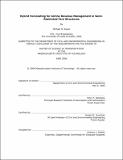Hybrid forecasting for airline revenue management in semi-restricted fare structures
Author(s)
Reyes, Michael H. (Michael Hamilton)
DownloadFull printable version (5.799Mb)
Other Contributors
Massachusetts Institute of Technology. Dept. of Civil and Environmental Engineering.
Advisor
Peter P. Belobaba.
Terms of use
Metadata
Show full item recordAbstract
In recent years, the airline industry has seen diminished performance of traditional Revenue Management (RM) systems largely due to the growth of Low Cost Carriers and the increased use of their "simplified" fare structures. With the removal of many of the fare restrictions essential to RM systems, standard demand forecasters can no longer segment demand and passengers are able to book air travel in fare classes lower than their actual willingness to pay. These "semi-restricted" fare structures typically contain several homogenous fare classes undifferentiated except by price, as well as several distinct fare classes with unique combinations of booking restrictions and advance purchase requirements. This thesis describes" Hybrid Forecasting" (HF) -- a new technique which separately forecasts "product-oriented" demand using traditional forecasting methods, and "price-oriented" demand for passengers who purchase only in the lowest priced fare class available when booking. The goal of this thesis is two-fold: to first measure the potential benefit of Hybrid Forecasting in terms of network revenue in semi-restricted fare structures, and then to measure potential improvements to Hybrid Forecasting. (cont.) "Path Categorization" attempts to improve revenues by exploiting the expected higher level of passenger willingness-to-pay for non-stop service versus connecting service. And "Fare Adjustment" accounts for passenger sell-up behavior from lower to higher fare classes, and is applied within an RM system's seat inventory optimizer. Experiments with the Passenger Origin-Destination Simulator demonstrate that HF in these semi-restricted fare structures can improve an airline's network revenue by approximately 3% compared to traditional forecasting methods. This improvement grows by 0.25% with Path Categorization, by 1% with Fare Adjustment, and by up to 2.5% over Hybrid Forecasting alone with Path Categorization and Fare Adjustment together -- all significant impacts on an airline's network revenue. Though these results are encouraging, the revenue gains of these new RM forecasting methods are still not enough to offset the revenue loss associated with the easing of traditional fare class restrictions.
Description
Thesis (S.M.)--Massachusetts Institute of Technology, Dept. of Civil and Environmental Engineering, 2006. This electronic version was submitted by the student author. The certified thesis is available in the Institute Archives and Special Collections. Includes bibliographical references.
Date issued
2006Department
Massachusetts Institute of Technology. Department of Civil and Environmental EngineeringPublisher
Massachusetts Institute of Technology
Keywords
Civil and Environmental Engineering.